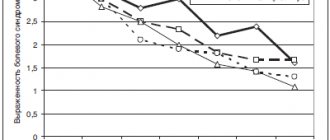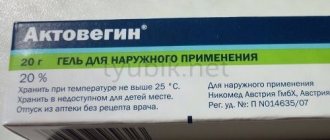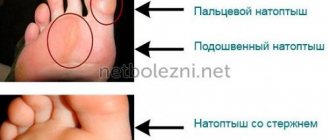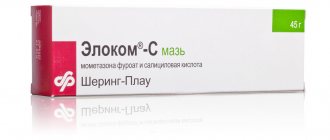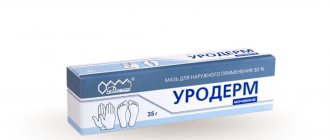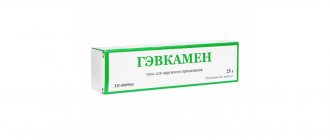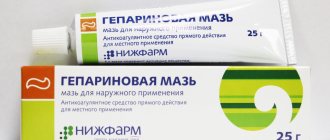Pharmacodynamics and pharmacokinetics
The active component of the drug, Flumethasone , is a synthetic bifluorinated corticosteroid intended for external use. The substance has anti-inflammatory , antiallergic , antipruritic , decongestant and vasoconstrictor effects. By acting on the skin, the drug helps prevent the marginal accumulation of neutrophils , reducing inflammatory exudate and the production of lymphokines, inhibits the migration of macrophages, reduces the processes of infiltration and granulation, and so on.
Clioquinol or iodochlorooxyquinoline is a derivative of 8-hydroxyquinolines. Its activity is manifested against yeast fungi, dermatophytes, and gram-positive bacteria. In addition, the antiexudative effect of Flumethasone .
The combined effect of Flumethasone and Clioquinol suppresses the development of various inflammatory and allergic reactions on skin surfaces, which can be complicated by bacterial or fungal infections.
Thanks to its fatty base, the ointment has a softening and water-repellent effect, which is provided by a protective film that protects the skin from moisture. This drug is suitable for use by patients with dry and thin skin.
After applying the product to the skin, its active substances penetrate the stratum corneum. In this case, flumethasone pivalate is not absorbed into the bloodstream and does not have a systemic effect. Increased absorption occurs as a result of frequent use of the ointment or its application to large areas of the skin. This can also be expected when using the product on the face, in skin folds, in places of damage to the epidermis, under an occlusive dressing. It should be noted that in children the effect of the substance is especially pronounced. Clioquinol in the ointment is absorbed through the skin, binding to blood plasma proteins.
The active substances are slightly metabolized in the skin structure. Mostly this process occurs in the liver. The components are then excreted from the body in urine or bile.
Pharmacodynamics
Due to flumethasone, it has a pronounced anti-inflammatory, antiallergic, and antipruritic effect. Reduces permeability and changes the structure of tissue and cell membranes, reduces the migration of macrophages and lymphocytes, affects all phases of inflammation, blocks the release of histamine and other biologically active substances from sensitized mast cells and basophils. The clioquinol contained in the composition causes antimicrobial activity (against most gram-positive and gram-negative bacteria and fungi), and also enhances the antiexudative effect of flumethasone.
Contraindications for use
This drug is not prescribed for:
- skin tuberculosis;
- viral skin lesions, such as chickenpox or herpes ;
- syphilis with manifestations on the skin;
- precancerous conditions and skin tumors;
- perioral dermatitis ;
- period after vaccination;
- acne;
- trophic ulcers caused by varicose veins ;
- under 10 years of age;
- hypersensitivity.
Directions for use and doses
Externally. The ointment is applied in a thin layer to the affected areas of the skin, at the beginning of treatment - 2-3 times a day, when positive dynamics appear - 1-2 times a day; Duration of use - no more than 2 weeks. If necessary, use a bandage that allows air to pass through. In case of excessive lichenification and hyperkeratosis - only under an occlusive dressing once every 24-48 hours, for no more than 1 week.
Unnecessarily, you should not use more than 2 g of ointment per day.
In adolescents over 10 years of age - only in exceptional cases, on limited areas of the skin, avoiding applying the drug to the skin of the face.
Side effects
The use of the drug Lorinden C can cause: burning, stretch marks, folliculitis , itching and dry skin. Long-term use leads to the development of: purpura, skin atrophy , telangiectasia, pigmentation disorders, local hirsutism . When the product is applied to large areas for a long time, side effects characteristic of GCS may occur.
Lorinden® A
The course of continuous therapy is no more than 2 weeks.
Avoid contact of Lorinden® A ointment with the eyes and mucous membranes. If, when using Lorinden® A ointment externally, there are signs of irritation, increased dry skin or allergies, as well as increased side effects or effects not specified in the instructions, you should stop treatment and consult a doctor.
With long-term use and/or application to large surfaces of the skin, wounds, damaged skin, the use of large doses, when using occlusive dressings and when treating children with Lorinden® A ointment, systemic absorption of glucocorticosteroid and salicylic acid is possible; it is possible to suppress the function of the hypothalamic-pituitary-adrenal system and develop symptoms of hypercortisolism.
During drug therapy, periodic monitoring of the function of the adrenal cortex is necessary by determining the concentration of cortisol in the blood and urine after stimulation of the adrenal glands with adrenocorticotropic hormone (ACTH).
In case of development of a secondary bacterial or fungal infection, it is necessary to prescribe external use of an antibacterial or antifungal drug. If symptoms of infection persist, you should stop using Lorinden® A until the infection has resolved.
Lorinden® A should be used with caution on the skin around the eyes or eyelids due to the risk of developing glaucoma or cataracts, as well as in patients with a history of these diseases, who may experience an exacerbation of these diseases.
Lorinden® A should be used with extreme caution on the skin of the face and intertriginous skin (skin folds, armpits, groin area, crooks of the arms and legs), due to increased absorption of glucocorticosteroids through thin skin and the possibility of side effects (telangiectasia, skin atrophy , perioral dermatitis) even after short-term use.
The drug Lorinden® A is used with caution under an occlusive dressing due to increased absorption of glucocorticosteroids into the blood; since atrophy of the epidermis, striae and infection may develop.
The drug should be used with caution in case of atrophic changes in the subcutaneous tissue, especially in the elderly.
Lorinden® A should be used with extreme caution in patients with psoriasis, due to the possible relapse of the disease caused by the development of tolerance, the risk of generalized pustular psoriasis and general toxicity due to pressure ulcers.
Children and teenagers
Lorinden® A ointment should be used with caution, especially as long-term therapy, in children over 2 years of age, since in this group of patients, due to a higher ratio of body surface area to body weight than in adults, dysfunction may develop more quickly hypothalamic-pituitary-adrenal system and undesirable effects characteristic of glucocorticosteroids may occur, including growth and development retardation.
Propylene glycol, lanolin and salicylic acid contained in Lorinden® A may cause irritation at the site of application, including allergic reactions (for example, contact dermatitis).
Interaction
The simultaneous use of Lorinden S and other external agents is not permissible. When the drug is applied to large areas of the skin, the absorption of Flumethasone can reduce the effect of insulin , other hypoglycemic agents, antihypertensive drugs and anticoagulants. In addition, the risk of negative effects of anticholinergic drugs, anabolic steroids, oral contraceptives, androgens, estrogens, antipsychotics, azathioprine , bucarban, diuretics, nitrates, tricyclic antidepressants, antihistamines, cardiac glycosides increases. The immunosuppressive effect of this drug requires refraining from vaccinations and immunizations.
Analogs
In modern pharmacology, there are analogues of this drug: Flumethasone, Lorinden, Lorinden A. Drugs similar in action include: Dexamethasone, Prednisolone, Diprospan, Methylprednisolone , etc.
Reviews of Lorinden S
As reviews of Lorinden S show, this external remedy is one of the most popular. It is prescribed for a wide variety of skin lesions, and in most cases, it turns out to be very effective.
However, some patients report that the positive effect of the drug lasts only for a while, that is, it simply inhibits the development of unwanted symptoms. After stopping the use of Lorinden S, patients begin to experience the same disorders again.
According to experts, this treatment result was noted when prescribing an external remedy without sufficient examination by specialists, since often people do not even know exactly what Lorinden S ointment is for. Also, many reviews of the ointment contain information that patients often use the drug on their own without contacting to the doctor. Therefore, in such cases, one should not exclude either a temporary cessation of the symptoms of the disease or the development of all kinds of side effects.
Lorinden A 15 g ointment in tube
Instructions for medical use of the drug LORINDEN® A Trade name Lorinden® A International nonproprietary name No Dosage form Ointment Composition 1 g of ointment contains active substances - flumethasone pivalate 0.2 mg, salicylic acid 30.0 mg, excipients: propylene glycol, anhydrous lanolin , white Vaseline up to 1 g. Description White with a light yellow tint, fatty soft mass. Pharmacotherapeutic group Flumethasone in combination with other drugs. ATX code D07XB01 Pharmacological properties Pharmacokinetics Flumethasone pivalate easily penetrates the stratum corneum of the epidermis, where it accumulates. Not metabolized in the skin. To a small extent it can penetrate the body after local application and have a general effect. After absorption, it is metabolized mainly in the liver. It is excreted in the urine and in smaller quantities with bile in the form of compounds with glucuronic acid and in small quantities unchanged. Absorption of flumethasone pivalate through the skin increases after application to the skin of the axillary and groin areas or to the skin of the face, skin with damaged epidermis or damaged as a result of an inflammatory process. The use of an occlusive dressing, which causes an increase in skin temperature and humidity, also increases the absorption of flumethasone pivalate. In addition, absorption increases with frequent use of the drug or when it is applied to a large surface of the skin. Absorption through the skin is stronger in young people than in adults. Salicylic acid has a local effect on the skin surface, facilitating the penetration of glucocorticosteroids through excessively keratinized epidermis. Pharmacodynamics Lorinden® A is a combination drug; the properties of the ointment are due to the combination of the action of flumethasone pivalate and salicylic acid. Flumethasone pivalate is a synthetic glucocorticosteroid that has a moderate anti-inflammatory effect. Used in an ointment at a concentration of 0.1%, it has a moderate effect. It has lipophilic properties, easily penetrates the stratum corneum of the skin and has anti-inflammatory, antipruritic and antiallergic effects. After topical application of flumethasone, pivalate inhibits the formation of prostaglandins and leukotrienes in the skin by stopping the activity of phospholipase A2 and reducing the release of arachidonic acid from cell membrane phospholipids; phagocytosis, the release of interleukins and other cytokines that cause inflammatory processes, inhibits the release of histamine and the formation of local allergic reactions. Reduces the manifestations of hypersensitivity reactions, proliferative and exudative processes occurring in the connective tissue at the site of inflammation, reduces hyperemia. Salicylic acid promotes the penetration of glucocorticosteroids and gives the drug additional antiparakeratotic, moderate keratolytic properties and local hypothermic effect, promotes the penetration of flumethasone into the skin. In addition, it has an antibacterial and fungicidal effect, and also restores the protective mantle of the skin. Indications for use Lorinden® A in the form of an ointment is used topically, in particular against an allergic background, not complicated by a secondary bacterial infection, accompanied by hyperkeratosis and persistent itching: - seborrheic and atopic dermatitis - urticarial lichen - allergic contact eczema - erythema multiforme - lupus erythematosus - psoriasis - lichen planus. Method of use and dosage A small amount of ointment is applied in a thin layer to the affected areas of the skin, no more than 1-2 times a day. In case of severe lichenification or hyperkeratosis, the use of an occlusive dressing is allowed, which should be changed once a day. Treatment should not be carried out without a break for more than 2 weeks. Do not apply to facial skin for more than 1 week. Within one week, you can use no more than 15 g of ointment (1 tube). In children over 2 years of age, use with extreme caution only if necessary, once a day, on a small surface of the skin. Do not use on the face, do not use under occlusive dressings in children. Side effects - acne, post-steroid purpura, inhibition of epidermal growth, subcutaneous tissue atrophy, skin atrophy and striae - dry skin, hypertrichosis or baldness, depigmentation or pigmentation of the skin - telangiectasia - perioral dermatitis - furunculosis, secondary infection Rarely - urticaria or maculopapular rash or exacerbation of existing changes - under an occlusive dressing it can cause a resorptive effect in the form of edema, arterial hypertension, a decrease in the body's resistance to infections - when used on the skin of the eyelids, glaucoma or cataracts can develop - when used on large surfaces of the skin, systemic side effects characteristic of glucocorticosteroids are possible Contraindications - hypersensitivity to glucocorticosteroids, salicylic acid and components of the ointment base - skin tuberculosis - post-vaccination reactions - bacterial, viral and fungal infections of the skin - common and rosacea - skin manifestations of syphilis - skin tumors - weeping and exudative stages of skin diseases - chicken pox - phlebitis (against the background of varicose veins), trophic ulcer - extensive damage to the skin with skin defects (burns) - 1st trimester of pregnancy - children under 2 years of age Drug interactions There are no known cases of drug interactions with topical use of glucocorticosteroids. However, it should be remembered that it is impossible to vaccinate patients against smallpox and other types of immunization, especially with long-term use on a large surface of the skin, taking into account the possibility of the lack of an adequate immunological response in the form of the appearance of appropriate antibodies. Lorinden® A may enhance the effect of immunosuppressive drugs and weaken the effect of immunostimulating drugs. Special instructions Do not use without interruption for more than 2 weeks. With prolonged use over a large surface of the body, the frequency of side effects increases. With topical use of flumethasone pivalate, a decrease in ACTH production may occur due to inhibition of the pituitary-adrenal axis, a decrease in the level of cortisol in the blood and the development of iatrogenic Cushing's syndrome, which disappears after cessation of treatment. Periodic monitoring of the function of the adrenal cortex is indicated by determining cortisol in the blood and urine after stimulation of the adrenal glands with ACTH. If an infection develops at the site of application of the ointment, appropriate antibacterial or antifungal treatment should be carried out. If symptoms of infection do not go away, you should stop using the ointment while the infection is being treated. The use of the drug on the skin in the eyelid area should be avoided in persons with closed-angle and open-angle glaucoma, as well as in persons with cataracts, given the possibility of increased symptoms of the disease. On the skin of the face, as well as on the skin of the groin and axillary area, use only in cases of special need, taking into account increased absorption and the high risk of side effects (telangiectasia, dermatitis perioralis), even after short-term use. Use with caution in existing conditions of subcutaneous tissue atrophy, especially in the elderly. Pregnancy and lactation Lorinden® A can be used in women in the second and third trimesters of pregnancy only when the benefit of use in the mother outweighs the potential risk to the fetus. It is recommended to take particular care when using Lorinden® A ointment in nursing women. If necessary, apply only briefly to a small surface of the skin, do not apply to the skin of the chest. Features of the influence on the ability to drive a vehicle and potentially dangerous mechanisms The drug does not limit psychomotor activity, the ability to drive vehicles and maintain moving mechanisms. Overdose Symptoms: after prolonged use on a large surface of the skin, the following symptoms may occur: swelling, arterial hypertension, decreased resistance to infections, and in severe cases, the development of Cushing's syndrome. Rarely, symptoms of salicylate poisoning may occur. Treatment: the drug should be gradually discontinued and therapy with a lower concentration of glucocorticosteroids should be used. Release form and packaging 15 g of ointment in aluminum tubes, along with instructions for medical use in the state and Russian languages in a cardboard box, 1 tube each. Storage conditions Store at a temperature not exceeding 25oC. Keep out of the reach of children! Shelf life: 3 years Do not use after expiration date. Conditions for dispensing from pharmacies By prescription Manufacturer Jelfa Pharmaceutical Plant A.O. 58-500, Jelenia Gora, st. V.Polya, 21, Poland. Owner of the registration certificate OOO Valeant, Russia Address of the organization that accepts claims from consumers regarding product quality in the Republic of Kazakhstan Representative office of OOO Valeant in the Republic of Kazakhstan Kazakhstan, 050059, Almaty, Al-Farabi Avenue, 17, Block 4B, office 1104 Phone + 7 727 3 111 516, fax +7 727 3 111 517 Email
Lorinden S price, where to buy
In Moscow pharmacies, the price of Lorinden C ointment for external use varies between 242-308 rubles.
- Online pharmacies in RussiaRussia
- Online pharmacies in UkraineUkraine
- Online pharmacies in KazakhstanKazakhstan
ZdravCity
- Lorinden S ointment 15gJelfa SA
RUR 439 order
Pharmacy Dialogue
- Lorinden S (ointment tube 15g)Jelfa
RUB 467 order
show more
Pharmacy24
- Lorinden C 15 g ointment Farmzavod Elfa A.T., Poland
111 UAH order
PaniPharmacy
- Lorinden C ointment Lorinden C ointment 15g Poland, Jelfa
126 UAH order
show more
